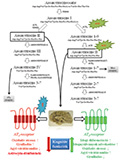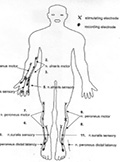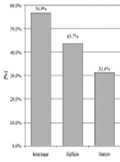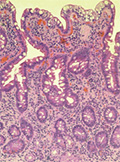The eLitMed.hu medical portal uses computer cookies for convenient operation. Detailed information can be found in the Cookie-policy.
Clinical Neuroscience - 2014;67(05-06)
Content
[The effect of angiotensin receptor blockers in cerebrovascular disorders and dementia: Bonus in addition to the antihypertensive effect]
[Hypertension and dementia are frequent disorders or rather syndromes. Their incidence is growing with advancing age and hypertension is increasing the risk of cognitive impairment too, while treating hypertension (i.e. the use of antihypertensive medications) is decreasing it. In addition, hypertension is the most important risk factor for stroke. The renin-angiotensin system (RAS) has a special role in the development of hypertension and also involved in the pathogenesis of the most frequent dementia form, namely Alzheimer’s disease. The effect of angiotensin convertase inhibitors and angiotensin receptor blockers (ARB) is based on the inhibition of the RAS, but the ARBs do not inhibit angiotensin formation, just blocking its harmful effects on the AT1 receptor, while allowing the activation of AT2 receptors with pleiotropic effects. Preclinical, epidemiological and clinical therapeutic studies suggest this additional effect of ARBs and these are summarized in this review.]
[The Comprehensive Headache-related Quality of life Questionnaire shows significant improvement after withdrawal treatment in medication overuse headache: a pilot study]
[Background and purpose - Medication overuse headache (MOH) is a common form of disabling headache presenting in as much as 30% of the patients seen in headache subspecialty practice. Quality of life (QOL) is frequently used as a secondary endpoint in headache trials. In MOH, previous trials of QOL focused mostly on generic QOL. We report the results of a pilot study that examined the feasibility of using a new QOL questionnaire, the 23-item Comprehensive Headache-related Quality of life Questionnaire (CHQQ), as an indicator of treatment response in MOH. Patients and methods - Fifteen patients (13 women and two men; mean age: 39.7±12.5 years) suffering from MOH were enrolled in a complex treatment programme consisting of acute medication withdrawal, preventive pharmacological treatment, structured advice and lifestyle intervention. The clinical data were collected using a detailed headache diary. CHQQ was completed before and after the treatment programme. Results - MOH patients had low QOL values at baseline which was comparable to the QOL of episodic migraine patients. The treatment programme resulted in significant reductions of the number of headache days and attacks, headache severity and analgesic consumption. The dimensions and total score of CHQQ showed a significant increase after the treatment period. Seventeen of CHQQ’s 23 individual items also improved significantly. Conclusion - In this study the new headache-specific quality of life instrument CHQQ was able to demonstrate significant improvements after adequate treatment of MOH. This result indicates that the CHQQ may be an adequate tool for assessing quality of life in headache treatment trials.]
[Temperature sensitivity of some nerve conduction parameters in diabetic polyneuropathy]
[Background - We tested whether in diabetic polyneuropathy the temperature dependence of the median nerve conduction parameters reflects the severity of neuropathy. Methods - We validated an electrophysiological score against clinical signs of polyneuropathy. Electroneurography was performed at temperatures from 20-40 °C in diabetic patients with mild, moderate and severe neuropathy and controls. Results - The electrophysiological score reflected the clinical severity of polyneuropathy. At room temperature there were significant differences among groups in almost all parameters. In thermal sensitivity studies were significant differences in distal and proximal motor and sensory areas and in sensory conduction velocities. These four parameters normalized to 1 °C change in temperature also significantly differed among the four groups and were largest in controls and smallest in severe polyneuropathy. Conclusions - The use of an integral parameter - areas are essentially amplitudes integrated over time - increases the probability of detecting decreased thermal sensitivity of peripheral nerves in diabetes.]
[Organization of National Neurofibromatosis Register and fields of its application]
[Background and purpose - The neurofibromatosis is a rare genetic disease with increased tumor growing ability and different special symptoms (Riccardi-criteria). The National NF Register has been organized by NF Hungary in 2011. The idea was initiated by hungarian neurofibromatosis experts. Methods - The register contains data about the therapists, the hospitals and the patients. The data are recorded by retrospective method and followed in time, so the register can track progress. Furthermore the register has valid nutrition, physical activity and psychological data, so the users are able to make comparisons with the clinical information. Results - 225 persons are registerd in the system on NF Hungary and 37 patients belong to the NF National Register. The number of the patients, who are member of the register, is always increasing. From the 37 persons 22 are females (60%) and 15 males (40%), 18 adults (48%) and 19 underagedes (52%). Conclusion - NF Register is a very useful system to do research and to draw public health and popolazione conclusions. The register enhances the morbidity details (time of manifestation, progressione, prognostical factors, prognosis), thereby could improve the cooperation and the coverage of the patients. The system is open for the patients as well, so it can give information to the patients about new scientific results, new medical methods and current availavable medications.]
[Analysis of patients applying for emergency treatment with vertigo related symptoms]
[Objective - Analyzing the medical record data of patients with the main symptom of vertigo in “Kaposi Mór” Hospital’s Emergency Department. Method - Retrospective evaluation of patients’s medical history with vertigo related diagnoses according to BNO classification. Results - In the year of 2010, 18 000 patients were presented to ED. In 471 cases the symptoms were vertigo related which makes up 3% of the total. Almost half, 46% of these patients were brought in by ambulance medical car. The ratio of women was twice as high as of the men. One fifth, 19% of patients with vertigo gained admission to the ward and 81% of them were discharged in 24 hours. According to the interviews, 4 types of vertigo have been identified: “whirling style” vertigo in 37% of the cases, dizziness in 33% of the cases, presyncope in 12% and „light headedness” in 9%. The remaining 9% couldn’t be classified. Conclusion - Vertigo is common presenting symptom in emergency department, however it rarely indicates severe condition. The diagnostic value of vertigo classification based on history and brain CT result in identifying the severity of the background condition is questionable. We found that in recognizing the cases which need prompt intervention, thorough neurological examination and the clarification of the vertigo’s circumstances proved to be helpful.]
[Impaired aortic elastic properties in young females with migraine]
[Migraine is a common health problem affecting women more commonly. It has been associated with an increased risk for cardiovascular events. In this study, we investigated whether aortic elastic properties is altered in migraineurs with low cardiovascular risk compared with healthy controls, in order to elicit further evidence on tentative association between migraine and increased risk of cardiovascular disease. Methods - Forty-three migraine patients with low CVD risk were enrolled to the study. Thirty-three volunteers, with a similar age and sex distribution served as a control group. Following parameters of the aortic elasticity were calculated: aortic strain, aortic stiffness (β) index and aortic distensibility. Results - Aortic strain was not statistically different between the study and control group. However, aortic distensibility and β index were significantly impaired in patients with migraine compared to control subjects Discussion - The elastic properties of the aorta in migreineurs may be different from normal by using easily available echocardiographic methods. This information may be a clue for clarification of cardiovascular system involvement in migraine.]
[LADA type diabetes, celiac diasease, cerebellar ataxia and stiff person syndrome. A rare association of autoimmune disorders]
[Celiac disease - in its typical form - is a chronic immunemediated enteropathy with typical clinical symptoms that develops against gliadin content of cereal grains, and is often associated with other autoimmune diseases. In cases of atypical manifestation classic symptoms may be absent or mild, and extra-intestinal symptoms or associated syndromes dominate clinical picture. The authors present a longitudinal follow-up of such a case. A 63-years old woman was diagnosed with epilepsy at the age of 19, and with progressive limb ataxia at the age of 36, which was initially thought to be caused by cerebellar atrophy, later probably by stiff person syndrome. At the age 59, her diabetes mellitus manifested with type 2 diabetic phenotype, but based on GAD positivity later was reclassified as type 1 diabetes. Only the last check-up discovered the celiac disease, retrospectively explaining the entire disease course and neurological symptoms. By presenting this case, the authors would like to draw attention to the fact that one should think of the possibility of celiac disease when cerebellar ataxia, progressive neurological symptoms and diabetes are present at the same time. An early diagnosis may help to delay the progression of disease and help better treatment.]
[Efficacy and safety of natalizumab in multiple sclerosis: data from the first five years of TOP (Tysabri Observational Program) study]
[Efficacy and safety of natalizumab in multiple sclerosis: data from the first five years of TOP (Tysabri Observational Program) study 2014;67(05-06)]
1.
Clinical Neuroscience
[Headache registry in Szeged: Experiences regarding to migraine patients]2.
Clinical Neuroscience
[The new target population of stroke awareness campaign: Kindergarten students ]3.
Clinical Neuroscience
Is there any difference in mortality rates of atrial fibrillation detected before or after ischemic stroke?4.
Clinical Neuroscience
Factors influencing the level of stigma in Parkinson’s disease in western Turkey5.
Clinical Neuroscience
[The effects of demographic and clinical factors on the severity of poststroke aphasia]1.
2.
Clinical Oncology
[Pancreatic cancer: ESMO Clinical Practice Guideline for diagnosis, treatment and follow-up]3.
Clinical Oncology
[Pharmacovigilance landscape – Lessons from the past and opportunities for future]4.
5.











